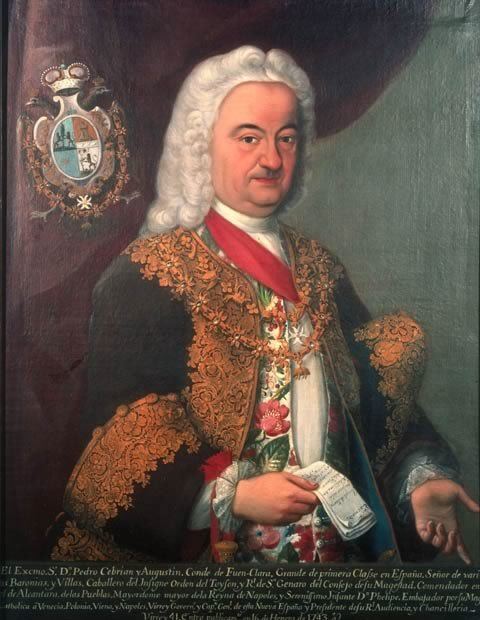Monarch Philip V Religion Catholic | Spouse(s) Maria Teresa Patino Name Pedro 5th | |
 | ||
Preceded by The Duke of la Conquista Succeeded by The Count of Revillagigedo Died August 22, 1752(1752-08-22) (aged 65)
Madrid, Spain | ||
Pedro Cebrian y Agustin, 5th Count of Fuenclara, Grandee of Spain, (April 30, 1687, Luceni, Spain – August 22, 1752, Madrid) was a Spanish diplomat and viceroy of New Spain, from November 3, 1742 to July 8, 1746.
Contents
Early life
He was Spanish ambassador extraordinary to the courts of Vienna, Dresden and Naples. He was majordomo and equerry to the Infante Don Felipe. He was honored with membership in the orders of the Golden Fleece, 1738, and San Gennaro. On January 31, 1742, King Philip V of Spain personally named Cebrian viceroy of New Spain.
As Viceroy of New Spain
He arrived in Veracruz on October 5, 1742. He made his solemn entry into the capital on November 3, 1742 and took up his office. He replaced Pedro Malo de Villavicencio, president of the royal Audiencia, who had been filling in since the death of the previous viceroy, Pedro de Castro y Figueroa, Duke of la Conquista.
As viceroy, he repaired the aqueduct from Chapultepec to Salta del Agua and paved many streets in Mexico City. He repaired and widened the Calzada de San Antonio Abad. He also established the estancos (government monopolies) in gunpowder, salt mines, ice and juego de gallos (cockfighting). He banned cards and dice.
In accordance with instructions from Spain, Cebrian y Agustin gathered ethnological, historical and statistical information about the colony. He directed the geographer Jose Antonio Villasenor y Sanchez to prepare an official estimate of the population of New Spain, to be transmitted to the Court. The estimate was completed in April 1744, and the population was found to be 3,865,000. Another result of this information-gathering was Villasenor's book, Theatro Americano, descripcion general de los reinos y provincias de la Nueva Espana (2 vols., 1746–48). The work is a very valuable source for colonial historians.
On June 2, 1743, after an investigation, he imprisoned the Italian knight Lorenzo Boturini Bernaducci (1702–53). Boturini had been soliciting public donations to crown the Virgin of Guadalupe with a gold crown, and also of introducing papal documents without a royal permit. At the time of his arrest, various valuable documents, codices, and writings about antique cultures that Boturini had collected were confiscated, and never returned to him. In 1744 Boturini was sent to Spain, where he established his good intentions and was freed. The king named him historian of the Indies. He even received permission to return to New Spain. In Madrid he wrote a history of ancient Mexico, unpublished at the time of his death in 1753.
On July 1, 1743, the British Admiral George Anson captured the China treasure galleon Nuestra Senora de Covadonga off the Philippines, en route from Manila for New Spain. The merchandise and the 1,318,843 pesos of silver ingots it was carrying were taken. Anson sold his prize for £400,000 in China. The viceroy was accused of perfidy in the affair, but of course nothing came of that.
In 1744 there was a riot in Puebla over a minor religious point. The viceroy, in order to dignify his visit to the bishop, had ordered the bells rung. The population interpreted this as a sign of the canonization of a previous bishop, Juan de Palafox y Mendoza, which many people had been campaigning for. When that turned out not to be the case, they rioted. The viceroy ordered the troops of the garrison to suppress the riot, and there were injuries. The viceroy was criticized for this decision.
Escandon expedition
In the 1740s Spain, because of encroachments of the French from Louisiana and the English along the Gulf coast, decided that they would have to complete the conquest of the Seno Mexicano (the Gulf coast, especially Tamaulipas and Texas). A council of war meeting was held to consider this project from May 8 to 13, 1743. Various officers presented plans, and that of Jose de Escandon was chosen as the most comprehensive. The viceroy sent this expedition to explore and colonize Nuevo Santander (Tamaulipas), which left Mexico City on March 5, 1744.
He became sick. He asked to be relieved his position and returned to Spain in July 1746. He died in Madrid August 6, 1752.
